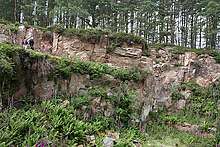Hopeman Sandstone Formation
| Hopeman Sandstone Formation Stratigraphic range: Late Permian to Early Triassic | |
|---|---|
 Cuttieshillock Quarry, locality of some of the reptile fossils | |
| Type | Formation |
| Underlies | Burghead Sandstone Formation |
| Overlies | Devonian Upper Old Red Sandstone |
| Area | Moray Firth |
| Thickness | 61 to 70 metres |
| Location | |
| Region | Scotland |
| Country | United Kingdom |
| Type section | |
| Named for | The location around Hopeman, Scotland, where it outcrops |
The Hopeman Sandstone Formation is a geologic formation in Scotland.[1] It preserves fossil footprints and body fossils from the Guadalupian Epoch in the Late Permian, to the Early Triassic,[2] It preserves fossils and fossil footprints from various extinct animals such as pareiasaurs and dicynodonts, which are collectively often referred to as the Elgin Reptiles.
The formation, named for the village of Hopeman, lies unconformably over the Devonian Upper Old Red Sandstone, and it underlies the waterlain sandstones of the Burghead Sandstone Formation. It represents a windswept dune landscape.
The Hopeman Sandstones were previously referred to as the Cutties Hillock Sandstone, Quarry Wood Sandstones, Sandstones of Hopeman, and Hopeman-Cummingstown Sandstone, but these names have since been superseded.
Lithology
The Hopeman Sandstone Formation is predominantly composed of fine- to coarse-grained yellowish sand with well rounded grains, mostly deposited as wind-blown dunes, but occasionally deposited by sheet floods.[1] Basal beds are pebbly and the unit varies, exhibiting large-scale crossbedding to fine rarely contorted laminations. Some beds are friable, while others hard and siliceous.[1]
See also
References
- 1 2 3 The BGS Lexicon of Named Rock Units: Hopeman Sandstone Formation
- ↑ Walker, AD. 1973. The age of Cuttie's Hillock Sandstone (Perm-Triassic) of the Elgin Area. Scottish Journal of Geology 9:177-183.
External links
- Various Contributors to the Paleobiology Database. "Fossilworks: Gateway to the Paleobiology Database". Archived from the original on 31 July 2014. Retrieved 8 July 2014.